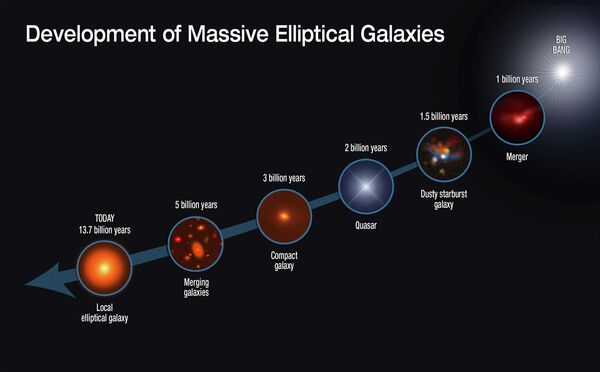The team of scientists, lead by Chris Harrison from the Centre for Extragalactic Astronomy at Durham University in the UK, used the National Science Foundation's Very Large Array (VLA) to study the elliptical galaxy “J1430+1339,” also known as the “Teacup,” due to its shape.
Elliptical galaxies, which are “gas poor” and exhibit little star-forming activity, are distinguished from more active, rich-in-gas spiral galaxies. Scientists now believe elliptical galaxies may have started life as their richer, star-forming sisters, but the tempest-like atmosphere from supermassive black holes within destroyed much of the material used to create stars.

"It appears that a supermassive black hole is explosively heating and blasting around the gas in this galaxy and, as a result, is transforming it from an actively star-forming galaxy into one devoid of gas that can no longer form stars," Harrison said.
"For many years, we've seen direct evidence of this happening in galaxies that are extremely bright when viewed through radio telescopes. These, rare, radio-bright galaxies harbor powerful jets, launched at the black hole, that plow into the surrounding gas," he continued. "However, to understand how all of galaxies in our Universe formed, we needed to know if these same processes occur in less extreme galaxies that better represent the majority. This was the focus of our study."
The VLA observations have shown that the Teacup galaxy has “bubble”-like structures that extend 30,000-40,000 light-years on each side of the galaxy’s core. There are also smaller “jet” like structures in which there is visible light activity, indicating some star formation.

Alasdair Thomson, another Durham astronomer involved in the study, said, "These radio observations have revealed that the central black hole is whipping up a storm at the center of this galaxy, by launching powerful jets that are accelerating the gas in the host galaxy and are colliding with the gas on larger scales. This is the same kind of powerful process we'd previously seen in rare, extremely radio-luminous galaxies. The incredible capabilities of the VLA have allowed us to discover that these processes can occur in the more-common, radio-faint galaxies, as long as you look hard enough."
"This 'storm' in the 'Teacup' means that the jet-driven process in which a black hole is removing or destroying star-forming material may be much more typical than we knew before, and could be a crucial piece in the puzzle of understanding how the galaxies we see around us were formed," Harrison said.




